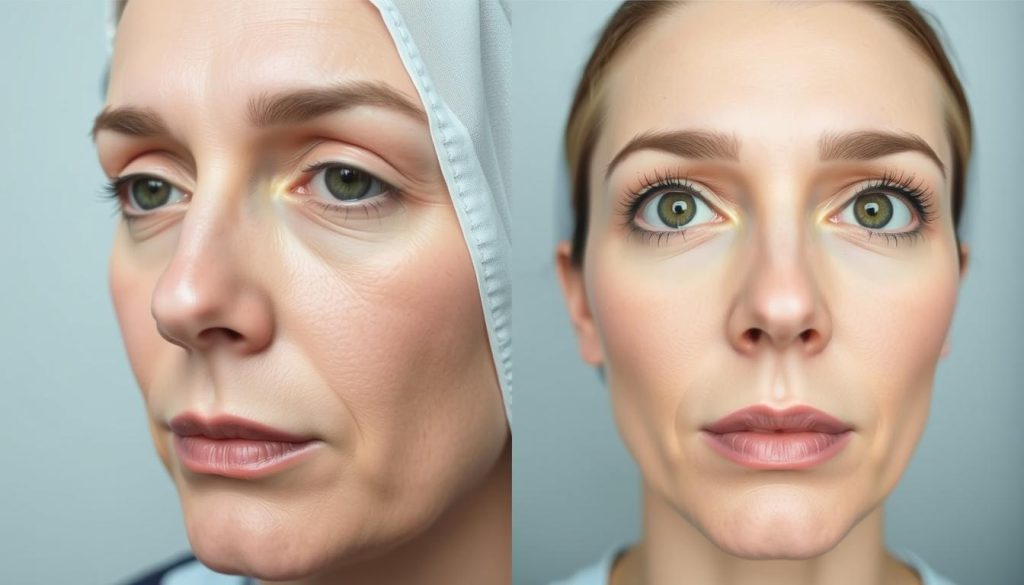Eyelid lift surgery, also known as blepharoplasty, is a highly individualized procedure designed to rejuvenate the appearance of the eyes by addressing common age-related concerns.
As we age, the skin around our eyelids becomes thinner and more delicate, leading to sagging skin, wrinkles, and puffiness.
Blepharoplasty can effectively treat these issues, restoring a naturally youthful and refreshed appearance to tired-looking, aging eyes.
By addressing sagging upper eyelids, puffy lower eyelid bags, and excess skin, this procedure can also improve peripheral vision in some patients.
Key Takeaways
- Cosmetic eyelid surgery rejuvenates the appearance of the eyes.
- Blepharoplasty addresses sagging skin, wrinkles, and puffiness.
- The procedure can improve peripheral vision.
- Modern techniques focus on natural-looking results.
- Eyelid surgery is a highly individualized procedure.
Understanding Plastic Surgery Eyes: What is Blepharoplasty?

Blepharoplasty, or eyelid surgery, is a surgical procedure aimed at improving the appearance of the eyelids by removing excess skin, fat, or muscle. For individuals looking to rejuvenate their eye area, blepharoplasty is a surgical option that can address various concerns.
The Anatomy of Aging Eyes
As people age, the eyelids undergo significant changes, including the loss of skin elasticity and the accumulation of fat. This can lead to a tired or aged appearance.
Common Eye Concerns Addressed by Surgery
Blepharoplasty can address several common concerns, such as drooping eyelids, excess skin, and protruding fat. By correcting these issues, individuals can achieve a more youthful and refreshed look.
Key Terminology in Eyelid Surgery
Understanding key terms like ptosis (drooping of the upper eyelid) and transconjunctival incision (an incision made inside the lower eyelid) can help patients better comprehend their surgical options. Key terms related to blepharoplasty include:
- Blepharoplasty: The medical term for eyelid surgery.
- Ptosis: Drooping of the upper eyelid due to muscle weakness.
- Transconjunctival approach: An incision made on the inside of the lower eyelid.
Types of Cosmetic Eyelid Procedures
Eyelid surgery encompasses a range of procedures designed to rejuvenate the eye area. These procedures can address various concerns, from excess skin to drooping eyelids, enhancing both the appearance and functionality of the eyes.
Upper Eyelid Blepharoplasty
Upper eyelid blepharoplasty is a surgical procedure that removes excess skin and fat from the upper eyelid, giving the eyes a more alert and youthful appearance. This procedure can be performed alone or in conjunction with other eyelid surgeries.
Lower Eyelid Blepharoplasty
Lower eyelid blepharoplasty focuses on addressing concerns related to the lower eyelid, such as under-eye bags and excess skin. By removing or repositioning fat and tightening the skin, this procedure can significantly reduce the appearance of aging around the eyes.

Ptosis Repair Surgery
Ptosis repair surgery is a specialized procedure designed to correct drooping eyelids caused by weakened muscles. This surgery involves tightening the levator muscle to improve eyelid function and appearance. Ptosis repair is often considered medically necessary when the condition interferes with vision, and it may be covered by health insurance.
- Ptosis repair surgery specifically targets the levator muscle to restore a more symmetrical eyelid position.
- Unlike standard upper blepharoplasty, ptosis repair focuses on reinforcing the muscle that elevates the eyelid.
- The procedure requires precise adjustments to ensure proper eyelid alignment and function.
Benefits and Ideal Candidates for Eyelid Surgery
With its ability to address both aesthetic and functional issues, eyelid surgery has become a sought-after procedure. Eyelid surgery, also known as blepharoplasty, can significantly enhance the appearance of the eyes, making it an attractive option for individuals looking to rejuvenate their look.

Aesthetic Improvements from Blepharoplasty
Blepharoplasty can lead to aesthetic improvements by removing excess skin and fat from the eyelids, resulting in a more youthful and alert appearance. This procedure can address concerns such as hooded eyelids and under-eye bags, enhancing overall facial aesthetics.
Functional Benefits for Vision
In addition to aesthetic benefits, eyelid surgery can also provide functional benefits by improving vision obstructed by drooping eyelids. By removing excess skin, the procedure can enhance the field of vision, making it particularly beneficial for individuals with significant eyelid sagging.
Who Should Consider Eyelid Surgery
Ideal candidates for eyelid surgery include healthy adults with realistic expectations and noticeable excess skin or fat in the eyelid regions. Typically, candidates are over 35 years old, but younger individuals with genetically inherited traits like under-eye bags or hooded eyelids may also be suitable. Candidates should be non-smokers or willing to quit smoking several weeks before and after surgery. Those with certain medical conditions should discuss their suitability with a plastic surgeon.
- Healthy adults with realistic expectations
- Individuals with noticeable excess skin or fat in the eyelid regions
- Non-smokers or those willing to quit smoking
- Those with certain medical conditions should consult their surgeon
The Consultation Process: Preparing for Eyelid Surgery

Preparing for eyelid surgery involves a crucial step: the consultation process. This initial visit is where you’ll meet with a surgeon to discuss your goals, concerns, and the details of the procedure.
What to Expect During Your Initial Visit
During your consultation, you’ll discuss your medical history, including any previous surgeries or health conditions. The surgeon will examine your eyes and eyelids to assess the best approach for your eyelid surgery.
Medical Considerations and Evaluations
The consultation will also involve a thorough evaluation of your eye health and a discussion about the type of anesthesia that will be used during the procedure. This is crucial for ensuring your safety and comfort during surgery.
Questions to Ask Your Surgeon
It’s essential to come prepared with questions for your surgeons, such as their experience with eyelid lift procedures, the technique they will use, and what kind of results you can expect from the lift. Discussing these details will help you feel more informed and confident in your decision.
The Blepharoplasty Procedure: Step by Step
Understanding the step-by-step process of blepharoplasty can help alleviate concerns for prospective patients. This surgical procedure is designed to rejuvenate the appearance of the eyelids.
Anesthesia Options and Pre-Surgery Preparation
Blepharoplasty is typically performed under local anesthesia, allowing the surgeon to assess the symmetry of the eyes during surgery. This approach ensures that the patient remains comfortable throughout the procedure.
Surgical Techniques and Incision Placement
The surgeon makes precise incisions along the natural creases of the eyelids to minimize visible scarring. The procedure involves carefully separating the skin from underlying tissue to access fat deposits and muscles.
Duration and What Happens During Surgery
The duration of blepharoplasty can vary, typically taking around 45 minutes to an hour for a single eyelid surgery, and up to two hours for combined upper and lower eyelid surgery. The surgeon will remove or reposition excess fat and remove excess skin before closing the incisions.
| Procedure | Duration | Key Steps |
|---|---|---|
| Upper Eyelid Blepharoplasty | 45 minutes | Incision, fat removal, skin closure |
| Lower Eyelid Blepharoplasty | 45 minutes | Incision, fat repositioning, skin closure |
| Combined Upper and Lower | Up to 2 hours | Both upper and lower procedures |
Throughout the procedure, the surgeon continually assesses symmetry to ensure balanced, natural-looking results. Proper care is taken to minimize scarring and promote healing.
Recovery and Long-Term Results After Eyelid Surgery
The recovery phase after eyelid surgery is crucial for achieving the desired outcome. During the first one to two weeks, patients may experience visible bruising and swelling, with their eyelids feeling unusually tight.
Using cold compresses and keeping the head elevated while sleeping can help alleviate discomfort. Most patients can return to their jobs within 10-14 days after an eyelid lift. With a healthy lifestyle and good skincare habits, the results of cosmetic eyelid surgery can last for years, providing a more youthful and refreshed appearance.
To maintain results, patients are advised to practice good skincare habits, including daily sun protection, and may benefit from complementary non-surgical treatments like skin resurfacing or Botox for crow’s feet. While eyelid surgery provides significant rejuvenation, it does not stop the natural aging process.
FAQ
What is the typical recovery time for blepharoplasty?
Swelling and bruising usually subside within a few days to a week, but it may take several weeks for the final results to be visible.
Will blepharoplasty improve my vision?
In some cases, excess skin on the upper eyelids can obstruct vision. Removing this excess skin can improve peripheral vision and alleviate vision problems caused by sagging eyelids.
Are there any risks or complications associated with eyelid surgery?
As with any surgical procedure, there are potential risks, including infection, scarring, and dry eye. However, when performed by a qualified surgeon, these risks are minimized.
Can blepharoplasty be combined with other facial procedures?
Yes, eyelid lift surgery can be combined with other facial procedures, such as skin resurfacing or facelifts, to achieve a more comprehensive facial rejuvenation.
How long do the results of blepharoplasty last?
The results of blepharoplasty can last for many years, but the aging process will continue. Maintaining a healthy lifestyle and using sun protection can help prolong the results.
What type of anesthesia is used for blepharoplasty?
Local anesthesia is often used for blepharoplasty, sometimes in combination with sedation to help the patient relax during the procedure.
